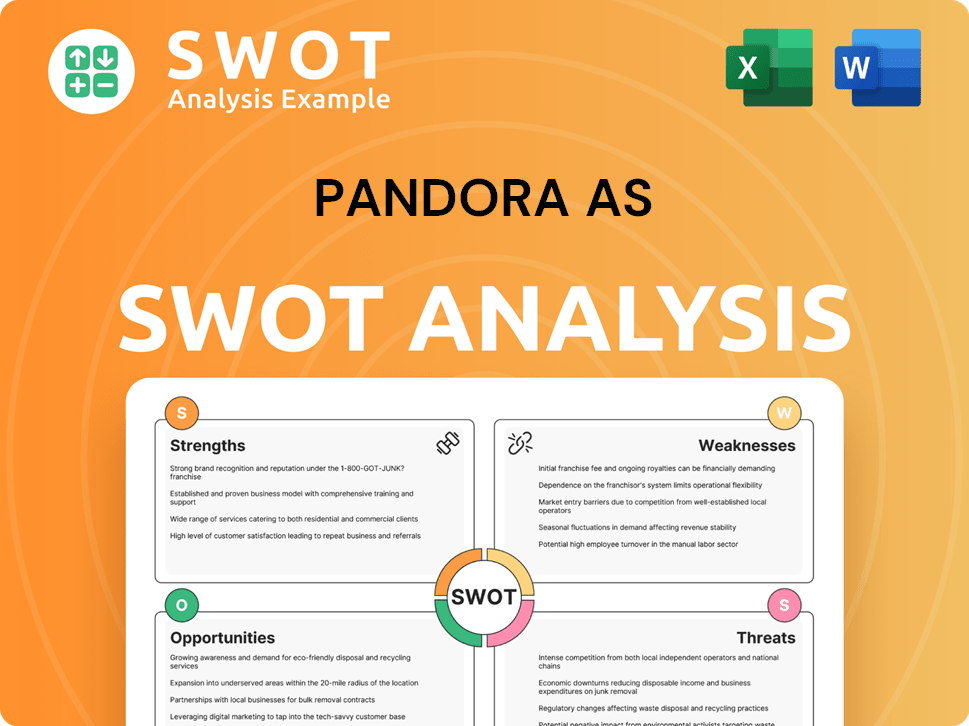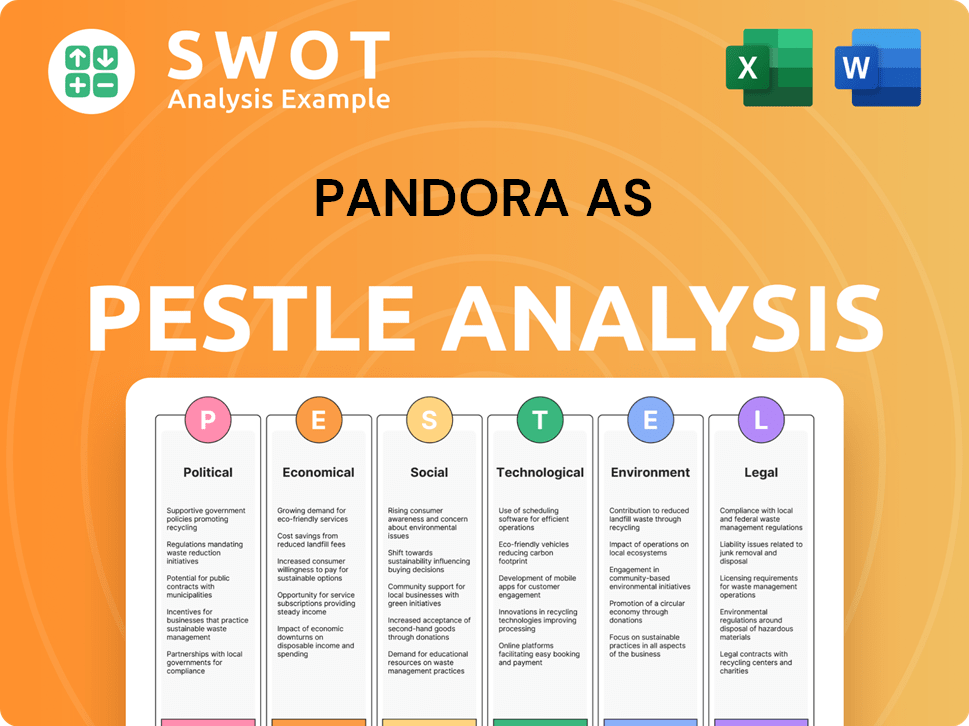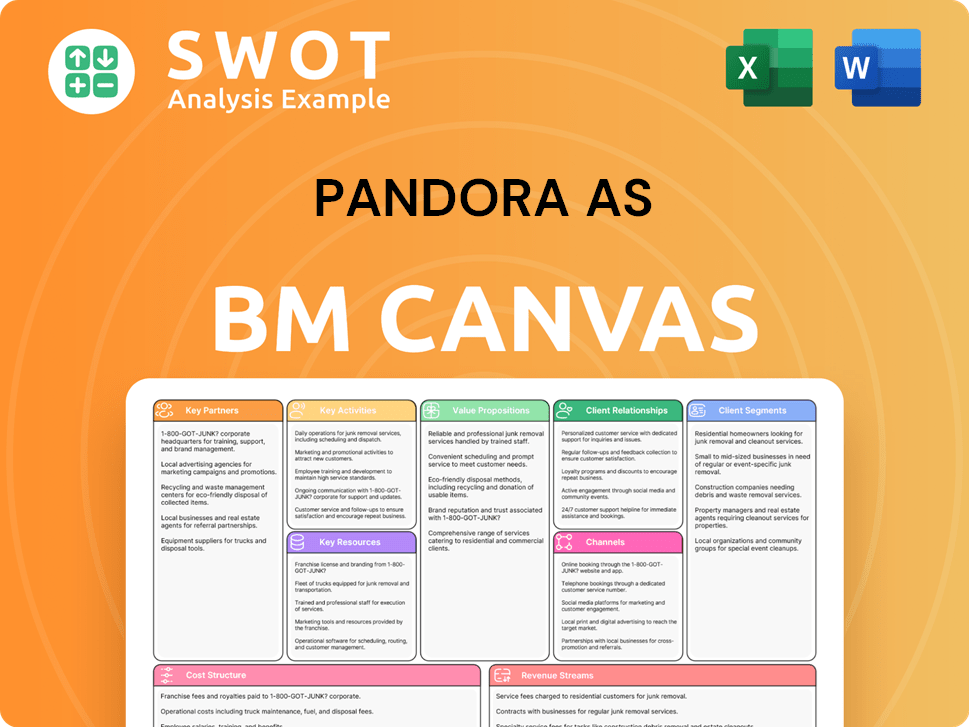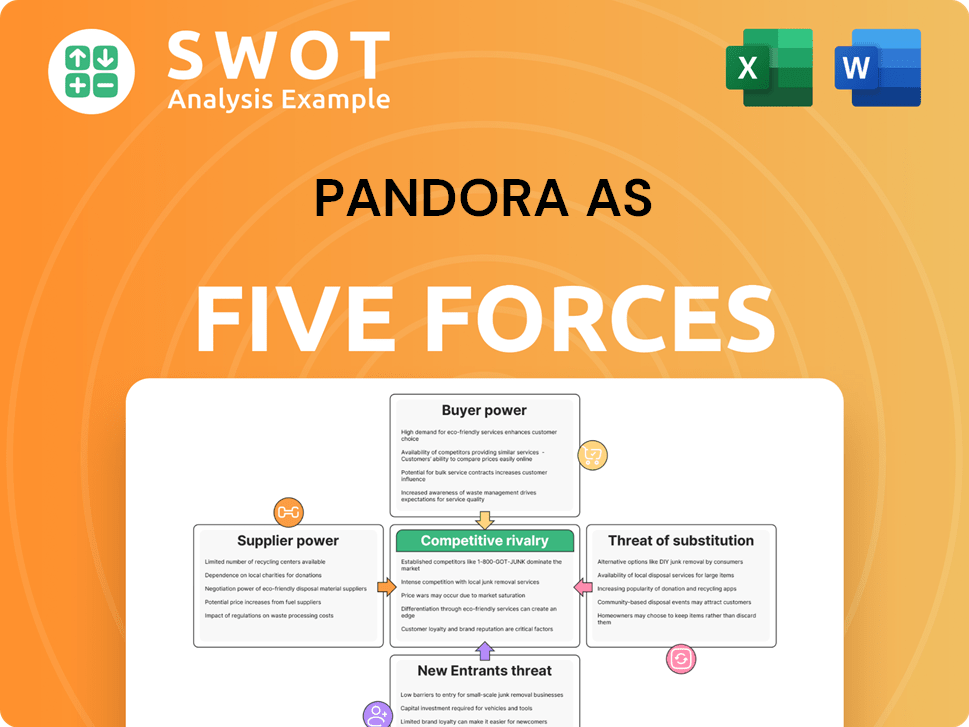Pandora AS Bundle
How Did Pandora Jewelry Conquer the World?
Ever wondered how a small Danish jeweler transformed into a global jewelry giant? Pandora AS, the name synonymous with charm bracelets, boasts a fascinating history of innovation and strategic growth. From its humble beginnings in Copenhagen, this Pandora AS SWOT Analysis reveals the pivotal moments that shaped its remarkable journey.

The story of Pandora AS history is one of visionary founders, Per and Winnie Enevoldsen, who disrupted the traditional jewelry market with affordable, customizable pieces. Their focus on accessible luxury and high-quality materials propelled the company from a local business to a multinational corporation. Explore the origins of Pandora jewelry and discover how its unique business model fueled its rapid expansion and global presence.
What is the Pandora AS Founding Story?
The story of Pandora AS, a global jewelry giant, began on April 1, 1982. This marked the official founding of the company by Per Enevoldsen and Winnie Enevoldsen, a couple with a vision to transform the jewelry market.
Their journey started with a simple yet effective business model. They imported jewelry from Thailand and sold it to Danish consumers. This approach allowed them to offer a variety of designs at competitive prices, quickly gaining popularity.
The early days of Pandora AS were marked by hands-on involvement. The first store in Copenhagen served as both a workshop and a retail space. The Enevoldsens were involved in every aspect of the business, from design and sourcing to sales. Their focus on individual expression through jewelry became a cornerstone of the brand. Initial funding came from the Enevoldsens’ personal savings and entrepreneurial spirit. Their expertise in both the creative and commercial aspects of jewelry laid the groundwork for Pandora's future success.
The company's early success was built on a keen understanding of market trends and consumer preferences.
- 1982: Pandora AS was founded.
- Early Strategy: Importing jewelry from Thailand.
- Core Value: Focus on individual expression.
- Initial Funding: Primarily bootstrapped.
The couple's commitment to quality and design, combined with a keen understanding of the market, set the stage for Pandora's future growth. The cultural context of Denmark at the time, with its appreciation for design and craftsmanship, also provided a fertile ground for the company's establishment and growth. The evolution of Pandora from a small Danish company to a global brand is a testament to their initial vision and strategic execution. For more details, explore the Revenue Streams & Business Model of Pandora AS.
Pandora AS SWOT Analysis
- Complete SWOT Breakdown
- Fully Customizable
- Editable in Excel & Word
- Professional Formatting
- Investor-Ready Format

What Drove the Early Growth of Pandora AS?
The early growth of the Pandora AS company was marked by strategic expansion in product offerings and market reach. The Pandora AS history includes a transition from importing to designing jewelry in 1987. Establishing a manufacturing facility in Thailand in 1989 was crucial for cost efficiency and scaling the business.
In 1987, the Pandora jewelry company shifted from importing jewelry to designing its own products. This move allowed for greater control over the brand's identity and product development. The establishment of a manufacturing facility in Thailand in 1989 was a key step in the company's evolution, enabling efficient production.
The launch of the customizable charm bracelet concept in Denmark in 2000 was a turning point. This innovative product became the signature offering, resonating with consumers. The success of the charm bracelet fueled rapid international expansion for the Danish jewelry brand.
Pandora's early years saw significant international expansion, entering the U.S. market in 2003. The company expanded into the German and Australian markets in 2004. By 2005, the first concept store opened in Australia, solidifying its retail presence.
Pandora AS financial history shows significant revenue growth, driven by the charm bracelets. By 2008, revenue reached DKK 1.2 billion, with a presence in over 20 countries. Product lines expanded beyond charm bracelets to include rings, necklaces, and earrings, broadening market share. For more insights, check out the Growth Strategy of Pandora AS.
Pandora AS PESTLE Analysis
- Covers All 6 PESTLE Categories
- No Research Needed – Save Hours of Work
- Built by Experts, Trusted by Consultants
- Instant Download, Ready to Use
- 100% Editable, Fully Customizable

What are the key Milestones in Pandora AS history?
The Pandora AS history is marked by significant achievements and strategic shifts. From its humble beginnings to its current global presence, the Pandora company has consistently adapted to market dynamics, establishing itself as a prominent player in the Danish jewelry industry.
| Year | Milestone |
|---|---|
| 2000 | Introduction of the Moments bracelet, revolutionizing the jewelry landscape with interchangeable charms. |
| 2005 | Expansion into international markets, marking the beginning of Pandora's global presence. |
| 2010 | Initial Public Offering (IPO), allowing the company to raise capital for further growth. |
| 2014 | Launch of the "ESSENCE" collection, expanding product offerings and targeting new customer segments. |
| 2020 | Announcement of commitment to use only recycled silver and gold in its jewelry by 2025, showcasing a shift towards sustainability. |
Pandora jewelry has consistently innovated, setting itself apart in the market. The introduction of the Moments bracelet was a groundbreaking innovation, protected by design patents. Further, major partnerships with Disney, Harry Potter, and Marvel have broadened its appeal.
The introduction of the Moments bracelet in 2000 allowed for personalized storytelling through interchangeable charms, fundamentally changing the jewelry landscape. This innovation was protected by design patents, securing Pandora's unique market position.
Partnerships with Disney, Harry Potter, and Marvel have broadened its appeal and customer base, introducing new themed collections that resonate with a global audience. These collections have allowed Pandora to tap into existing fan bases, driving sales and brand recognition.
In 2020, Pandora announced its commitment to using only recycled silver and gold in its jewelry by 2025. This commitment reflects a significant strategic shift towards sustainability, addressing growing environmental consciousness among consumers. This commitment is part of a broader strategy to appeal to environmentally conscious consumers.
Pandora has faced several challenges throughout its history. The company experienced a stock value decline between 2011-2012, prompting strategic adjustments. In response to changing consumer preferences and increased competition, the company has continuously innovated its designs and marketing strategies. For more insights, explore the Marketing Strategy of Pandora AS.
The company experienced a sharp decline in stock value due to concerns about its growth strategy and pricing. This led to a major strategic pivot, including a focus on improving product quality and optimizing its retail network.
Changing consumer demand for more sustainable products prompted Pandora to announce its commitment to using only recycled silver and gold in its jewelry by 2025. This commitment addresses growing environmental consciousness among consumers.
The company has faced internal crises related to supply chain management and inventory control, which it addressed through restructuring and investments in its operational infrastructure. These experiences have strengthened Pandora's resilience and adaptability.
Pandora AS Business Model Canvas
- Complete 9-Block Business Model Canvas
- Effortlessly Communicate Your Business Strategy
- Investor-Ready BMC Format
- 100% Editable and Customizable
- Clear and Structured Layout

What is the Timeline of Key Events for Pandora AS?
The Pandora AS history is marked by significant milestones that reflect its growth and adaptation in the jewelry market. Starting in 1982 with its establishment in Copenhagen, Denmark, by Pandora founder, Per and Winnie Enevoldsen, the company has evolved from a local business to a global brand. The introduction of the iconic Pandora Moments charm bracelet in 2000 was a pivotal moment, followed by expansions into North America, Germany, and Australia. A strategic shift occurred in 2010 when Pandora went public, and the company later implemented the 'Programme NOW' turnaround plan in 2019 to boost profitability. By 2023, Pandora reported strong financial results, achieving DKK 28.1 billion in revenue and an 8% organic growth in Q4 2023.
| Year | Key Event |
|---|---|
| 1982 | Per and Winnie Enevoldsen establish Pandora in Copenhagen, Denmark, marking the beginning of the Danish jewelry company. |
| 1989 | Pandora opens its manufacturing facility in Thailand, enhancing its production capabilities. |
| 2000 | The launch of the Pandora Moments charm bracelet in Denmark revolutionizes the charm bracelet market. |
| 2003 | Pandora enters the North American market, expanding its global footprint. |
| 2004 | Expansion into Germany and Australia further solidifies Pandora's international presence. |
| 2005 | The first Pandora concept store opens in Australia, enhancing brand visibility. |
| 2008 | Investcorp acquires a 60% stake in Pandora, influencing its strategic direction. |
| 2010 | Pandora goes public on the NASDAQ OMX Copenhagen stock exchange. |
| 2011-2012 | A period of significant stock price decline prompts strategic repositioning. |
| 2014 | Launches its 'Art of You' marketing campaign, focusing on self-expression. |
| 2019 | Initiates the 'Programme NOW' turnaround plan to improve profitability. |
| 2020 | Commits to using only recycled silver and gold in its jewelry by 2025, emphasizing sustainability. |
| 2023 | Reports strong financial results, with an 8% organic growth in Q4 2023 and a full-year organic growth of 7%, reaching DKK 28.1 billion in revenue. |
| 2024 | Continues global expansion, particularly in emerging markets, and focuses on digital transformation. |
Pandora is focused on expanding its presence in key growth markets. This includes strategic investments in regions with high growth potential, such as emerging markets. The company aims to increase its global footprint and reach a broader customer base.
There is a strong emphasis on digital transformation to enhance the online shopping experience. This includes improving e-commerce platforms and leveraging digital marketing strategies. The goal is to boost online sales and improve customer engagement.
Pandora plans to introduce new collections and expand existing lines, including lab-grown diamonds. This diversification aims to attract new customers and cater to evolving consumer preferences. Innovation in design and materials is a key focus.
The company's commitment to sustainability, such as using recycled precious metals, is a key driver for future growth. This commitment aligns with growing consumer demand for ethical products. Sustainability enhances brand appeal and supports long-term growth.
Pandora AS Porter's Five Forces Analysis
- Covers All 5 Competitive Forces in Detail
- Structured for Consultants, Students, and Founders
- 100% Editable in Microsoft Word & Excel
- Instant Digital Download – Use Immediately
- Compatible with Mac & PC – Fully Unlocked

Related Blogs
- What is Competitive Landscape of Pandora AS Company?
- What is Growth Strategy and Future Prospects of Pandora AS Company?
- How Does Pandora AS Company Work?
- What is Sales and Marketing Strategy of Pandora AS Company?
- What is Brief History of Pandora AS Company?
- Who Owns Pandora AS Company?
- What is Customer Demographics and Target Market of Pandora AS Company?
Disclaimer
All information, articles, and product details provided on this website are for general informational and educational purposes only. We do not claim any ownership over, nor do we intend to infringe upon, any trademarks, copyrights, logos, brand names, or other intellectual property mentioned or depicted on this site. Such intellectual property remains the property of its respective owners, and any references here are made solely for identification or informational purposes, without implying any affiliation, endorsement, or partnership.
We make no representations or warranties, express or implied, regarding the accuracy, completeness, or suitability of any content or products presented. Nothing on this website should be construed as legal, tax, investment, financial, medical, or other professional advice. In addition, no part of this site—including articles or product references—constitutes a solicitation, recommendation, endorsement, advertisement, or offer to buy or sell any securities, franchises, or other financial instruments, particularly in jurisdictions where such activity would be unlawful.
All content is of a general nature and may not address the specific circumstances of any individual or entity. It is not a substitute for professional advice or services. Any actions you take based on the information provided here are strictly at your own risk. You accept full responsibility for any decisions or outcomes arising from your use of this website and agree to release us from any liability in connection with your use of, or reliance upon, the content or products found herein.